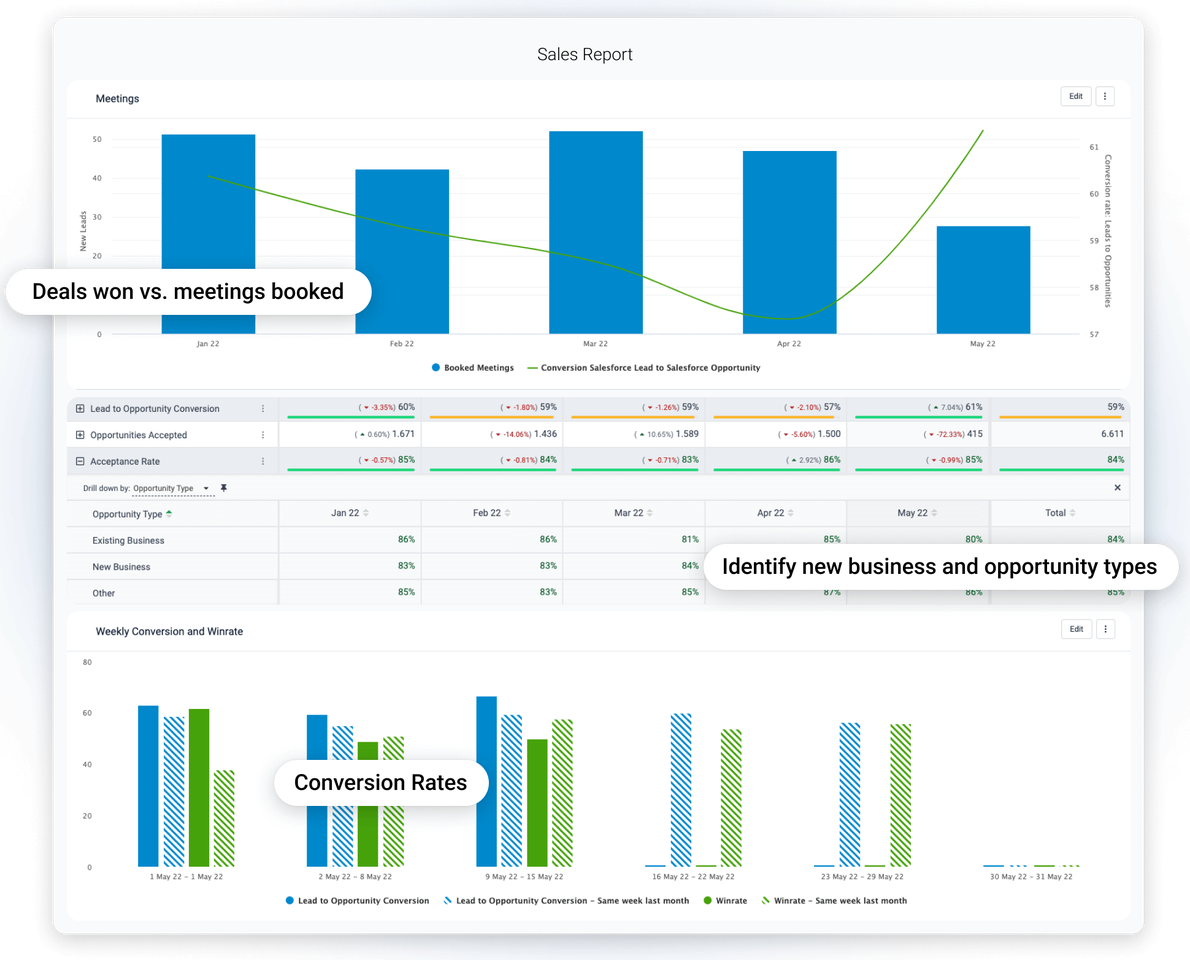Sales analytics is a broad topic. There are so many things to unpack from how to start to what type of sales analytics you can do.
And that’s what we are here for. We created a simple guide to analytics for sales to get you on the right track. Continue reading to find out why sales analytics are important, how to combine them with dashboards and so much more.
What is sales analytics?
Sales analytics is the name for the method by which sales data is collected and analyzed. The purpose of this process is to improve sales performance and thereby increase revenue. In order to perform sales analysis, sales data is needed. By having the right sales data, you can monitor sales trends, customer behavior, and market dynamics. The importance of sales analytics stems from the fact that it helps in making data-driven decisions, provides insight into what needs to be prioritized, and measures the impact of sales tactics.
Why is Sales Analytics important?
We have already briefly touched on the benefits of Sales Analytics but there is so much more. Sales Analytics like many other tools is designed to improve something. In this case, sales analytics helps improve overall sales performance more specifically by enabling you to make better data-driven decisions, improving the sales process, and yielding the best possible results. All this can be possible because sales analytics enables the sales team to better identify trends, realize new opportunities and increase revenue growth by sales strategy optimization. Sales Analytics can also impact customer loyalty by giving a better understanding of customer behavior to the sales team.
How to perform sales analytics?
Here are 5 steps to consider when performingsales analytics…
1.) Know what you want to analyze
2.) Set good objectives
3.) Choosing how you want to compile your data
4.) Visualization is key to success!
5.). See what needs to be prioritized and what trends to follow

1) Know what you want to analyze
This may seem obvious but it’s really that important that it has to be mentioned. There are so many data sources you will have and knowing what you want to focus on is a must! By knowing that, you now know what type of sales analytics you need to be doing, what factors you need to look at, what objectives you need to set and so much more. So whether it’s customer behavior or sales process you need to know what’s most important to you.
2) Set good objectives
Objectives can be whatever you want but a good objective is measurable, specific, and realistically reachable. So take a look at the factors you are analyzing and set specific goals you want to optimize.If you're needing some inspiration for when it comes to setting objectives, check out our blog on the 21 important sales KPIs.
3) Choosing how you want to compile your data
Now there are 2 options, you can either do it manually or using CRM and Sales Analytics software. By doing it manually you will probably opt for Excel or Google Sheets to keep track of your data. Now even though this is possible in today’s day and age, there are more practical options available so this one we wouldn’t recommend this one.
CRM and Sales Analytics software are more adaptable and efficient. You can use more than one and combine them, by using software like this you reduce the risk of any errors in your data.
4) Visualization is key to success!
By visualizing your data and your objectives, you can motivate and engage your team and improve sales processes also you don't have to spend hours going through a spreadsheet or CRM to find what matters.. There are multiple benefits of data visualization and Plecto is offering that with our real-time dashboards so keep on reading to find out why this is something you definitely need in your company!
Build your first dashboard.
Start your 14-day free trial today
5) See what needs to be prioritized and what trends to follow
If you are done with the previous steps it’s time for some real work. It’s time to put everything together and start improving. Analyze your data and see what needs to be changed or prioritized so that you can keep up with trends and reach your set objectives.
Types of analytics in sales
Now that you know the different benefits to sales analysis, you also know that each benefit requires certain data. Due to the fact that there are different types of sales data, there are also different sales analyses that complement them. As a company or sales manager, you can set certain objectives and thus determine what type of analysis you will conduct. Some analyzes are connected, so if you want to do one specific analysis, you need to do certain other analyzes before it. This is the case with predictive analysis, for example. Continue reading to find out which type of analysis suits you best.

Descriptive analytics
Descriptive analytics is all about past data specifically past sales data and it helps us picture what has happened. It concentrates on depicting characteristics of sales data, the distribution of sales by region, and trends in sales over time for example. It can also be used to find out connections and similarities in the data, since descriptive analytics, analyzes past sales performance. Because it focuses on past data it can also be a starting point for other analyses such as diagnostic, predictive, and prescriptive. Descriptive analysis is a popular method of analysis as: it gives a view of performance and trends on which the general business strategy can be based on, and helps recognize the company’s weaknesses and strengths.
Diagnostic analytics
Diagnostic analytics also focuses ont past data.. The difference however is that descriptive analytics is about understanding what happened, while diagnostic analysis is about determining the cause of past performance. Basically, diagnostic analytics is an analytical method that the sales team can use to determine changes in sales trends, customer behavior, or product performance. The purpose is to find connections and irregularities in sales data. With this information, it is possible to make assumptions about why sales were the way they were. After the first step has been taken, you can move on to designing tactics to improve and optimize sales and future results. The diagnostic analysis uses the following tools: data visualization, statistical analysis, and advanced algorithms.
Predictive analytics
Unlike descriptive and diagnostic analytics, predictive analytics focuses on future sales data. More specifically, predictive analyticsi uses historical and statistical algorithms to predict future sales and improve performance. Predictive analytics is also a great tool to use in order to gain insights into customer behavior since its software applies Al and Machine learning to conduct data on prospects and customers through the sales process. There is always a huge amount of data, and predictive analytics is good at summarizing that data. This turns it into a clear picture for your sales team so they can then find out how to best connect with customers, identifyf future market trends and set team goals.
Prescriptive analytics
Prescriptive analytics or simply put “What should we do next?” is a type of analytics that guides the sales team on how to optimize future sales using the information from predictive analytics. Based on that it’s quite useful for data-driven decision-making. In order to give recommendations, prescriptive analytics uses advanced algorithms and mathematical models and can examine numerous factors such as market trends, customer behavior, and sales data. Prescriptive sales analytics aims to better the effectiveness of sales processes, ultimately helping you to achieve improved results and increased revenue.
Real-time analytics
Real-time analytics is a type of analytics that focuses on current data, its purpose is to monitor real-time sales data and with that, it’s possible to quickly respond to changes. By being able to see sales data in real-time and quickly react, the sales team can efficiently improve their sales strategies, and make data-driven decisions that increase revenue. This is possible by using certain types of technologies, for example, cloud-based data platforms, mobile devices, and real-time dashboards. It’s fair to say that real-time dashboards are something that Plecto specializes in, so continue reading to find out more about how sales analytics can be visualized on Plecto’s real-time dashboards.
Customer Analytics
Customer Analytics is about monitoring the data related to customer behavior, preferences, and buying patterns in order to get a better understanding of customers and with that improve sales results. In order to get the data customer interactions, sales transactions, and many other possible sources are analyzed. With this knowledge sales teams can start working on their sales approach, and find ways to improve customer engagement and increase sales and revenue.

How sales analytics and Plecto dashboards work perfectly together.
If you got this far then by now you know that your objectives are essential for keeping you on the right track! When setting objectives the most common form of doing it is through KPIs or OKRs. The whole point of objectives or sales analytics is to make them visible to everyone, being a mushroom manager won’t do you any good, and by now it’s known that an informed and motivated team works the best. To achieve this it’s best to display your sales analytics on a dashboard. Plecto provides all the sales performance tools you need to achieve your KPIs.
Start now by signing up for a 14-day free trial and visualize your sales team’s performance on real-time dashboards.




